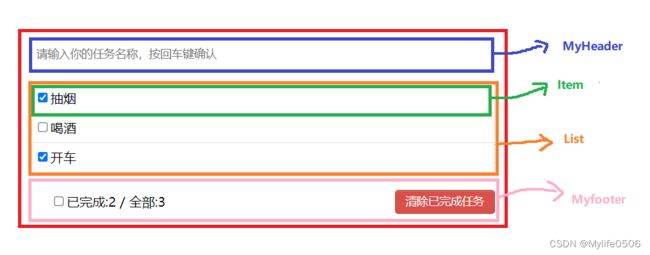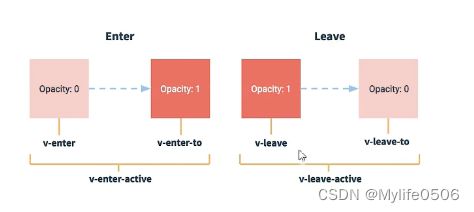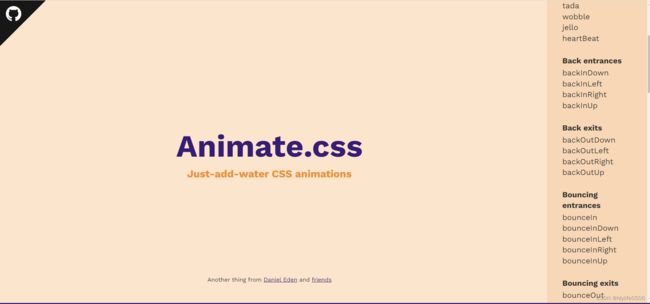【Vue全家桶】--- 第三章:Vue脚手架(Vue CLI)
文章目录
- 第三章:使用Vue脚手架(Vue CLI)
-
- 3.1、初始化脚手架
-
- 3.1.1、说明
- 3.1.2、具体步骤
- 3.1.3、模板项目的结构及配置
- 3.1.4、第一个脚手架实例
- 3.2、ref属性与props属性
-
- 3.2.1、ref属性
- 3.2.2、props属性
- 3.3、mixin(混入)
- 3.4、插件
- 3.5、scoped样式
- 3.6、TodoList
- 3.7、webStorage
- 3.8、组件的自定义事件
- 3.9、全局事件总线(GlobalEventBus)
- 3.10、消息订阅与发布(pubsub)
- 3.11、nextTick
- 3.12、Vue封装的过度与动画
第三章:使用Vue脚手架(Vue CLI)
3.1、初始化脚手架
3.1.1、说明
- 脚手架全名:Command line interface
- Vue 脚手架是Vue 官方提供的标准化开发工具(开发平台)
- 文档: https://cli.vuejs.org/zh/。
3.1.2、具体步骤
前提:先安装Nodejs
第一步(仅第一次执行):全局安装@vue/cli。
npm install -g @vue/cli
第二步:切换到你要创建项目的目录,然后使用命令创建项目
vue create xxxx
第三步:启动项目(在当前目录下执行)
npm run serve
备注:
如出现下载缓慢请配置 npm 淘宝镜像:
npm config set registry https://registry.npm.taobao.orgVue 脚手架隐藏了所有webpack 相关的配置,若想查看具体的webpakc 配置, 请执行:
vue inspect > output.js
3.1.3、模板项目的结构及配置
结构
├── node_modules
├── public
│ ├── favicon.ico: 页签图标
│ └── index.html: 主页面
├── src
│ ├── assets: 存放静态资源
│ │ └── logo.png
│ │── component: 存放组件
│ │ └── HelloWorld.vue
│ │── App.vue: 汇总所有组件
│ │── main.js: 入口文件
├── .gitignore: git版本管制忽略的配置
├── babel.config.js: babel的配置文件
├── package.json: 应用包配置文件
├── README.md: 应用描述文件
├── package-lock.json:包版本控制文件
配置
1.关于不同版本的Vue:
1.vue.js与vue.runtime.xxx.js的区别:
(1)vue.js时完整版的Vue,包含:核心功能+模板解析器
(2)vue.runtime.xxx.js是运行版的Vue,只包含:核心功能:没有模板解析器
2.因为vue.runtime.xxx.js没有模板解析器,所以不能使用template配置项,需要使用
render函数接收到的createElement函数去指定具体内容
2.修改默认配置文件(vue.config.js)
- 使用vue inspect > output.js可以查看到Vue脚手架的默认配置。
- 使用vue.config.js可以对脚手架进行个性化定制,详情见:https://cli.vuejs.org/zh
lintOnSave: false //关闭语法检查
3.暴露方式
第一种方式(分别):
export const school = Vue.extend({})第二种方式(同一):
export {school}第三种方式(默认==>推荐):
export default school 简化 export default Vue.extend({})
第三种更精简方式
3.1.4、第一个脚手架实例
main.js
/*
该文件时整个项目的入口文件
*/
//引入Vue (残缺版vue)
import Vue from 'vue'
//完整版Vue
//import Vue from 'vue/dist/vue'
/*
引入App组件,它是所有组件的父组件
*/
import App from './App.vue'
//关闭vue生产提示
Vue.config.productionTip = false
//创建Vue实例对象 vm
new Vue({
el: '#app',
//将App组件放入容器中
/* render(createElement) {
return createElement('h1', '你好')
} */
render: h => h(App)
})
App.vue
SchoolName.vue
学校名称:{{ name }}
学校地址:{{ address }}
Student.vue
学生名称:{{ name }}
学生年龄:{{ age }}
index.html
DOCTYPE html>
<html lang="">
<head>
<meta charset="utf-8">
<meta http-equiv="X-UA-Compatible" content="IE=edge">
<meta name="viewport" content="width=device-width,initial-scale=1.0">
<link rel="icon" href="<%= BASE_URL %>favicon.ico">
<title>硅谷系统title>
head>
<body>
<noscript>
<strong>We're sorry but <%= htmlWebpackPlugin.options.title %> doesn't work properly without JavaScript enabled. Please enable it to continue.strong>
noscript>
<div id="app">div>
body>
html>
3.2、ref属性与props属性
3.2.1、ref属性
- 被用来给元素或子组件注册引用信息(id的替代者)
- 应用在html标签上获取的是真实DOM元素,应用在组件标签上是组件实例对象(vc)
- 使用方式:
- 打标识:
或.....
- 获取:
this.$refs.xxx
3.2.2、props属性
-
功能:让组件接收外部传过来的数据
-
传递数据:
-
接收数据:
- 第一种方式(只接收):
props:['name'] - 第二种方式(限制类型):
props:{name:String} - 第三种方式(限制类型、限制必要性、指定默认值):
props:{ name:{ type:String, //类型 required:true, //必要性 default:'老王' //默认值 } } - 第一种方式(只接收):
备注:
props是只读的,Vue底层会监测你对props的修改,如果进行了修改,就会发出警告,若业务需求确实需要修改,那么请复制props的内容到data中一份,然后去修改data中的数据。
data() {
return {
myName:this.name
};
},
3.3、mixin(混入)
-
功能:可以把多个组件共用的配置提取成一个混入对象
-
使用方式:
第一步定义混合:mixin.js**(main.js同级目录)**
export const mixin = {//分别暴露 data(){....}, methods:{....} .... }第二步使用混入:
import {mixin} from '../mixin'- 全局混入:
Vue.mixin(xxx) - 局部混入:
mixins:['xxx']
- 全局混入:
3.4、插件
-
功能:用于增强Vue
-
本质:包含install方法的一个对象,install的第一个参数是Vue,第二个以后的参数是插件使用者传递的数据。
-
定义插件:plugins .js**(main.js同级目录)**
export default { install(Vue){ //全局过滤器 Vue.filter('mySlice',function(value){ return value.slice(0,4) }) //定义全局指令 Vue.directive('fbind',{ //指令与元素成功绑定时(一上来) bind(element,binding){ element.value = binding.value }, //指令所在元素被插入页面时 inserted(element,binding){ element.focus() }, //指令所在的模板被重新解析时 update(element,binding){ element.value = binding.value } }) //定义混入 Vue.mixin({ data() { return { x:100, y:200 } }, }) //给Vue原型上添加一个方法(vm和vc就都能用了) Vue.prototype.hello = ()=>{alert('你好啊')} } } -
引入并使用插件:
//引入插件
import plugins from './plugins'使用插件
Vue.use()//引入Vue import Vue from "vue"; //引入App import App from './App' //引入插件 import plugins from './plugins' //关闭Vue的生产提示 Vue.config.productionTip = false //创建vm //应用(使用)插件 Vue.use(plugins) new Vue({ el: '#app', render: h => h(App) });
3.5、scoped样式
- 作用:让样式在局部生效,防止冲突。
- 写法:
3.6、TodoList
- 组件化编码流程:
(1).拆分静态组件:组件要按照功能点拆分,命名不要与html元素冲突。
(2).实现动态组件:考虑好数据的存放位置,数据是一个组件在用,还是一些组件在用:
1).一个组件在用:放在组件自身即可。
2). 一些组件在用:放在他们共同的父组件上(状态提升)。
(3).实现交互:从绑定事件开始。
- props适用于:
(1).父组件 ==> 子组件 通信
(2).子组件 ==> 父组件 通信(要求父先给子一个函数)
使用v-model时要切记:v-model绑定的值不能是props传过来的值,因为props是不可以修改的!
props传过来的若是对象类型的值,修改对象中的属性时Vue不会报错,但不推荐这样做。
案例:后面会持续改良,请向下继续阅读
main.js
//引入Vue import Vue from "vue"; //引入App import App from './App' //关闭Vue的生产提示 Vue.config.productionTip = false //创建vm //应用(使用)插件 new Vue({ el: '#app', render: h => h(App) });App.js
MyHeader.vue
List.vue
Item.vue
MyFooter.vue
3.7、webStorage
存储内容大小一般支持5MB左右(不同浏览器可能还不一样)
浏览器端通过 Window.sessionStorage 和 Window.localStorage 属性来实现本地存储机制。
相关API:
xxxxxStorage.setItem('key', 'value');
该方法接受一个键和值作为参数,会把键值对添加到存储中,如果键名存在,则更新其对应的值。
xxxxxStorage.getItem('person'); 该方法接受一个键名作为参数,返回键名对应的值。
xxxxxStorage.removeItem('key'); 该方法接受一个键名作为参数,并把该键名从存储中删除。
xxxxxStorage.clear() 该方法会清空存储中的所有数据。
备注:
SessionStorage存储的内容会随着浏览器窗口关闭而消失。
LocalStorage存储的内容,需要手动清除才会消失。
xxxxxStorage.getItem(xxx)如果xxx对应的value获取不到,那么getItem的返回值是null。
JSON.parse(null)的结果依然是null。案例:以localStorage为例,sessionStorage类似
DOCTYPE html> <html> <head> <meta charset='UTF-8'> <title>localStoragetitle> head> <body> <h2>localStorageh2> <button onclick="saveData()">点我保存一个数据button> <button onclick="readData()">点我读取一个数据button> <button onclick="deleteData()">点我删除一个数据button> <button onclick="deleteAllData()">点我清空全部数据button> <script type="text/javascript"> let person = {name:'张三',age:15 } function saveData(){ //key 和 value 都必须是字符串,自动转换为字符串 localStorage.setItem('msg','hello') localStorage.setItem('person',JSON.stringify(person)) } function readData(){ console.log(localStorage.getItem('msg')) const result = localStorage.getItem('person') console.log(JSON.parse(result)) } function deleteData(){ localStorage.removeItem('msg') localStorage.removeItem('person') } function deleteAllData(){ localStorage.clear() } script> body> html>3.8、组件的自定义事件
- 一种组件间通信的方式,适用于:子组件 ===> 父组件
(在3.6、TodoList章节中采用的方式是:通过父组件给子组件传递函数类型propos实现)
使用场景:A是父组件,B是子组件,B想给A传数据,那么就要在A中给B绑定自定义事件(事件的回调在A中)。
绑定自定义事件:
第一种方式,在父组件中:
或父组件中
//两个写法xiaowang和m1 <Student v-on:xiaowang="getStudentName" @demo="m1"/> methods:{ getStudentName(name,...params){ console.log('App收到了学生名:',name,params) this.studentName = name }, m1(){ console.log('demo事件被触发了') } },子组件中
//可以写一个事件触发 <button @click="sendStudentName">把学生名字传给App</button> <button @click="sendStudentName">把学生名字传给App</button> <button @click="unbind">解绑xiaowang事件</button> <button @click="death">销毁当前Student组件的实例(vc)</button> methods:{ sendStudentName(){ //触发Student组件实例身上的xiaowang事件 //this.$emit('xiaowang',this.name,222,3333) //this.$emit('demo') //this.$emit('click') }, unbind(){ this.$off('xiaowang')//解绑一个自定义事件 //this.$off(['xiaowang','demo'])//解绑多个自定义事件 //this.$off()//解绑所有的自定义事件 }, death(){ this.$destroy()//销毁了当前的Student组件的实例,销毁后所有的Student实例的自定义事件全部不奏效 } },第二种方式:使用ref,在父组件中
<Student ref="student" @click.native="show"/><hr> methods:{ getStudentName(name,...params){ console.log('App收到了学生名:',name,params) this.studentName = name }, }, mounted(){ this.$refs.student.$on('xiaowang',this.getStudentName)//绑定自定义事件 /* this.$refs.student.$on('xiaowang',(name,...params)=>{ console.log('App收到了学生名:',name,params) this.studentName = name }) */ //this.$refs.student.$once('xiaowang',this.getStudentName)//绑定自定义事件:一次性 }
- 若想让自定义事件只能触发一次,可以使用
once修饰符,或$once方法。- 触发自定义事件:
this.$emit('atguigu',数据)- 解绑自定义事件
this.$off('atguigu')- 组件上也可以绑定原生DOM事件,需要使用
native修饰符。- 注意:通过
this.$refs.xxx.$on('atguigu',回调)绑定自定义事件时,回调要么配置在methods中,要么用箭头函数,否则this指向会出问题!**案例:**还是3.6的TODOList案例,结合3.6、3.7、3.8整合改良
App.vue
MyHeader.vue
MyFooter.vue
Item.vue、List.vue暂未做修改
3.9、全局事件总线(GlobalEventBus)
- 一种组件间通信的方式,适用于任意组件间通信。
- 安装全局事件总线:main.js中
new Vue({ el: '#app', render: h => h(App), //生命周期钩子,最先调用 beforeCreate() { /此时的this就是vm Vue.prototype.$bus = this //安装全局事件总线,$bus就是当前应用的vm }, ...... })
使用事件总线:
接收数据:A组件想接收数据,则在A组件中给$bus绑定自定义事件,事件的回调留在A组件自身。
mounted(){ this.$bus.$on('xxx',(data)=>{ ..... }) }提供数据:
this.$bus.$emit('xxxx',数据)最好在beforeDestroy钩子中,用$off去解绑当前组件所用到的事件。(提供数据的组件中)
beforeDestroy(){ this.$bus.$off('xxx')//进行销毁 },3.10、消息订阅与发布(pubsub)
建议使用全局事件总线
一种组件间通信的方式,适用于任意组件间通信。
使用步骤:安装pubsub:
npm i pubsub-js引入:
import pubsub from 'pubsub-js'(接收与发送都需要)接收数据:A组件想接收数据,则在A组件中订阅消息,订阅的回调留在A组件自身。
回调方法必须有两个参数
第一个参数:代表订阅名(例如下面的’hello’)
第二个参数:回调数据
methods(){ demo(_,data){......} } ...... mounted() { //此处三种写法 //第一种(不建议) this.pubId = pubsub.subscribe('hello',function(msgName,data){ console.log(this)//不使用箭头函数,此时为undefined }) //第二种 this.pubId = pubsub.subscribe('hello',(msgName,data)=>{ // console.log('有人发布了hello消息,hello消息的回调执行了',msgName,data) console.log(this)//不使用箭头函数,此时为undefined }) //第三种(建议):配合上面的methods this.pid = pubsub.subscribe('xxx',this.demo) //订阅消息 }提供数据:
pubsub.publish('xxx',数据)最好在接收数据beforeDestroy钩子中,用
PubSub.unsubscribe(pid)去取消订阅。3.11、nextTick
- 语法:
this.$nextTick(回调函数)- 作用:在下一次 DOM 更新结束后执行其指定的回调。
- 什么时候用:当改变数据后,要基于更新后的新DOM进行某些操作时,要在nextTick所指定的回调函数中执行。
例:判断todo是否包含isEdit属性
<button class="btn btn-edit" @click="handleEdit(todo)" v-show="!todo.isEdit" >编辑</button> //编辑 handleEdit(todo) { //判断是否包含isEdit属性 if (todo.hasOwnProperty('isEdit')) { //不包含则添加属性 this.$set(todo, "isEdit", true); } else { todo.isEdit = true; } //下一轮 this.$nextTick(function(){ this.$refs.inputTitle.focus() }) } //失去焦点回调(真正执行编辑逻辑) handleBlur(todo,e) { todo.isEdit = false; if(!e.target.value.trim()) return alert('输入不能为空!!!') this.$bus.$emit('updateTodo',todo.id,e.target.value) },3.12、Vue封装的过度与动画
作用:在插入、更新或移除 DOM元素时,在合适的时候给元素添加样式类名。
写法:
第一步:准备好样式
- 进入样式:
- v-enter:进入的起点
- v-enter-active:进入过程中
- v-enter-to:进入的终点
- 离开样式:
- v-leave:离开的起点
- v-leave-active:离开过程中
- v-leave-to:离开的终点
第二步:使用
包裹要过度的元素,并配置name属性:你好啊!
备注:若有多个元素需要过度,则需要使用:
,且每个元素都要指定key值。例:通过点击展示效果
单元素
你好啊!
多元素
你好啊!
你好啊!
你好啊!
你好啊!


